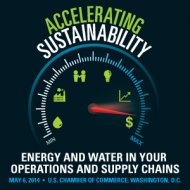US Chamber Of Commerce Aims To Promote Food Security Through Sustainable Management Of Water And Energy
Global demand for both water and energy is spiraling upward, with long-term implications for food security. Several private-sector initiatives have emerged to promote more coordination of energy and water issues, and this week the US Chamber of Commerce Foundation will offer insight into what works and what doesn’t.

5 May 2014 | Building sustainability in any business is difficult. It involves conserving natural resources like water and energy, which means altering the business model, spending money and testing new methods that may or may not work. For the brewery MillerCoors, it involved teaming up with The Nature Conservancy (TNC) to develop water efficient farming practices. The duo created a pilot project based on water conservation practices that saved 270 million gallons of water – enough to quench a family of four’s thirst for 1,850 years – in a one year period.
The project was initiated soon after the brewing company realized 90% of its water use occurred in the company’s agriculture supply chains. The initiative takes place in Idaho’s Silver Creek Valley, where much of the beer industry grows its barley. MillerCoors wanted to use less water in growing the crop without reducing yield. And they were able to accomplish that using techniques like precision irrigation, installing riparian plants streamside and wetland restoration and monitoring. The pilot project-Showcase Barley Farm-was able to conserve the 270 million gallons of water through these practices.
The efficient irrigation techniques also meant a reduction in energy use. Farmers were using less water which means they were using less power to pump water. The farm cut its energy use by more than half.
More and more companies are realizing the connection between water and energy and making various attempts to solve their version of the problem. To encourage the private sector along, the US Chamber of Commerce Foundation (CCF), a nonprofit affiliate of the US Chamber of Commerce, is hosting an event bringing together leaders from the private, public and NGO space to offer innovative strategies on how businesses can achieve sustainability and also grow revenue. The event, Accelerating Sustainability: Energy and Water in Your Operations and Supply Chains, takes place on May 6 and is in association with the US Business Council for Sustainable Development, the World Business Council for Sustainable Development and SustainAbility. Scaling up water, energy and food security measures will be the focus with a special look at sustainability-driven innovation and collaboration.
“Companies are encouraged to better understand the interconnections and interdependencies of energy, water, and food, and the impacts on their business,” says Jennifer Gerholdt, the Director of Environment at CCF. “Given how tightly linked these resources are, actions taken to alleviate pressures on one resource may result in negative consequences for the other resources.”
Therefore proper understanding is needed before action can be taken. And that is what the CCF’s event is promoting. The organization offers first steps for companies addressing the nexus: surveying and collecting data, assessing the risks and opportunities, and developing a plan to mitigate these risks.
Successful Solutions
The CCF recently released a report, Achieving Energy and Water Security: Scalable Solutions from the Private Sector, that profiled a number of businesses securing water and energy supplies through innovative initiatives. Gerholdt notes the importance of cross and multi-sector collaboration in these projects in order to truly solve nexus challenges.
“No one entity can solve these challenges by itself,” Gerholdt says. “We need better coordination among the increasing constituency of decision-makers, as well as new and more ambitious forms of collaboration that cut across the typical public-private, industry, national, and regional boundaries.”
The MillerCoors’ partnership with TNC in Idaho is one example. Another takes place in the Dutch seaport city of Terneuzen. It’s a public-private partnership between The Dow Chemical Company, the city of Terneuzen, water company Evides and the Water Board Scheldestromen (governmental body responsible for protecting the Zeeland province of the Netherlands from floods). The initiative involves recycling municipal and industrial wastewater.
Recycling water in Terneuzen is an ideal solution especially when considering the city lacks in freshwater. And competing demands between the city’s big users-agriculture, industry and the city itself-has led to poor water management. Dow Terneuzen is the largest chemical processing plant outside of the US and the city’s biggest employer. Through the project, Dow Terneuzen accepts the city’s wastewater, has it purified by Evides and then uses it to generate steam and power its manufacturing facilities. The plant uses 30,000 cubic meters of wastewater in its operations a day.
Dow’s project is another win on both the water and energy front. Compared to the energy intensive desalination process the company would be using to create freshwater, Dow has reduced its energy use by 95%. And this energy reduction is the equivalent of reducing carbon emissions by 60,000 tons a year. By 2020, the chemical company is aiming to only use recycled wastewater in its operations at Terneuzen.
Sharing is Caring
The Accelerating Sustainability forum should be an ideal platform for these different sectors to share their insights and success stores as well as learn about other approaches. It can provide businesses with the insight and knowledge they need to implement similar strategies into their own operations.
Gertholdt says, “There is a lot to be gained from sharing what’s worked so we can build off each other’s successes to meet and manage the growing global demand for energy and water that is sustainable, secure and affordable.”
Kelli Barrett is a freelance writer and editorial assistant at Ecosystem Marketplace. She can be reached at [email protected].
Please see our Reprint Guidelines for details on republishing our articles.

